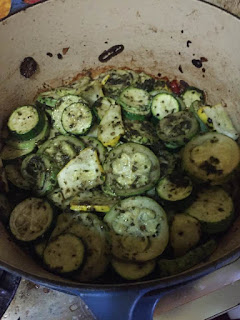This one, ragazzi, is about how you can play with recipes and get a good dish - maybe even a new one. You don't have to pretend each recipe is holy scripture - or maybe you should, because none of us are literalists, are we?
Last week, Annalena was sort of in a haze one night as she was planning dinner for the next night. "The best laid plans" do go astray, Annalena couldn't get to her market, so she needed to improvise. Well, she had some chicken, and she remembered reading a recipe for chicken roasted with figs. She found the recipe, but she did not have all the ingredients on hand, and the recipe called for an overnight marinade.
Know what? You can do this without the marinade. Also, the recipe called for black mission figs. When Annalena got to her fruit vendor (she always buys figs from a street vendor), he had green figs, no black ones.
Know what? The recipe works with green figs. Finally, she had no fresh rosemary.
You guessed it: it works with dried rosemary. And here's how it goes.
First, you turn your oven to 450. While that is happening, take four complete chicken legs (drumstick and thigh), and salt and pepper them well. Then, you combine them with 2 tablespoons of olive oil, a little grated peel, about a tablespoon of rosemary needles - fresh if you have it, dry if you don't. Put that in a bowl, and let it sit for about an hour (if you can, less if you can't).
Get half a pound of figs, and get the stem off of each one, then quarter them. Now, in calling for the black figs, the recipe is thinking of a jammy, almost sweet and sour sauce for the chicken, and that would have been delightful. Black figs cook down faster than the green ones do. By using the green ones, Annalena produced a chunkier, more solid dish. Your call.
So what you do is you lay the chicken that has marinaded, for however long, on a baking sheet. There will be space, and you add the figs. Finally, if you like roasted lemon (which Annalena does), you add slices of lemon:
Get this into your oven . We're going to roast this for about 40 minutes total. After twenty minutes:
Rotate the chicken. See, every restaurant, like everyone of us, has "hot spots," and you want to even things out. So after the rotation, let the thing cook for another twenty minutes (Incidentally, ragazzi, try to do this quickly, because you'd be stunned how rapidly the temperature of an oven drops with an opened door).
And after that final 20 minutes:
Some of you prefer your chicken to have darker, crispier skin. To do that here, take the tray out of the oven, move the temperature to the broiler setting, and put the chicken back in for a couple of minutes. These are legs, which have much more "juice" and fat than breasts, so they can take the heat. Check after two minutes, and if you've got what you want, you're done. Your lemons will crisp up, and the sugar in the figs will carmelize. None of that is a bad thing.
Then you serve it forth.
Figs are a fruit that does not travel well, ragazzi, so if you DO eat fruit out of season, understand that you will not find fresh figs after late autumn. So, as the commercial used to say DO IT NOW!!!
And that's it for this weekend kids. Watch the debates, register to vote if you didn't, and remember what's at stake. It's more than dinner















































